Sightseeing in Samara
Samara probably isn't the best town for hardcore sightseers in search of historic monuments and such. While there is plenty of interest in the city (see below), the biggest attraction for tourists is probably the beach along the banks of the Volga. But aside from the listed attractions, take some time to just wander around. Samara's streets boast many charming old wooden houses and large, serene parks abound in the center.
Volga Waterfront.
Samara's beaches are perhaps the city's biggest attraction. In the summer they are packed with
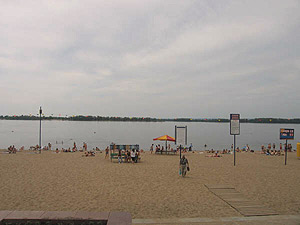 |
|
locals and holiday-makers soaking up the sun and swimming in the enticing waters of the Volga. The facilities on the beach are better than you would expect with change rooms, toilets and beach volleyball nets. If visiting Samara in summer then a swim is a must. Otherwise, traversing the full length of the beaches via the waterfront esplanade makes for a lovely stroll. Along the way you will come across many stalls selling souvenirs and other goods, numerous summer cafes boasting cheap beer and food and some of Samara's most famous sights including the Zhigulevsky Brewery, Iversky Monastery and the Monument of Glory. At a relaxed pace, walking the entire span of the waterfront could take a few hours.
Directions: The beach part of the waterfront basically starts where Leningradskaya Ulitsa intersects with Maksima Gorkovo Ulitsa. From there, you can follow it east on foot until the end of Volzhsky Prospekt.
Ploshchad Slavy and the Monument of Glory.
Ploshchad Slavy is Samara's requisite war memorial square and the spot where you will get the best possible views of the Volga.
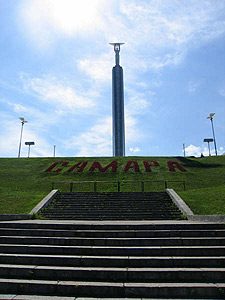 |
|
Taking pride of place on top of a grassed slope above the banks of Volga, which proudly proclaims the city's name painted in large, red letters, the dominant feature in the square is the Monument of Glory. Considered the 'symbol of Samara', the statue was built in honor of Samara's aviation workers during the Second World War. Hence the sexless figure at the top of the column is sporting a set of wings. The pedestal is some 40 meters high while the worker himself is an additional 13 meters tall. Not far from the statue is a war memorial replete with eternal flame. Ploshchad Slavy actually combines with Samarskaya Ploshchad to create one huge expanse. It is also the main administrative district of the city, with all the important government buildings located on the squares.
Directions: The two squares together take up a huge area. If you have the energy it's best to walk up the stairs from the riverside Volzhsky Prospekt to Ploshchad Slavy.
St George Cathedral.
At the north-eastern corner of Ploshchad Slavy stands the small
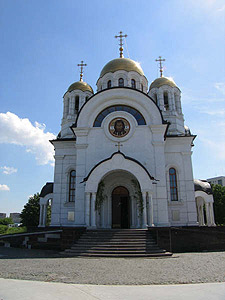 |
|
but attractive Cathedral of St George. A recent creation, the church was built in 2001 under the guidance of architect Yury Kharitinov in honor of the older and larger incarnation that was destroyed during the Communist era. The church looks a lot like a miniature version of Moscow's Christ the Savior Cathedral. Fitting with the general purpose of Ploshchad Slavy, the Cathedral of St George is devoted to Samara's war dead. Entrance to the church is free but unfortunately the interior isn't particularly impressive.
Iversky Women's Monastery.
Founded in 1850, the Iversky Women's Monastery, or nunnery, was once home to
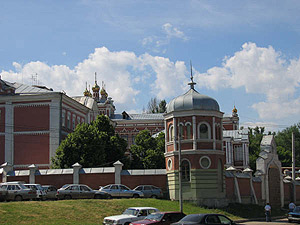 |
|
more than 500 nuns. The ensemble, which faces the Volga and includes chapels and a 70 meter belfry as well as accommodation for the sisters, is largely a late 19th and early 20th Century creation. The monastery was closed in 1925 and used as a residence for the workers at the Zhigulevsky Brewery across the street. Parts of the monastery were destroyed in the following years. Reopened in 1991, the monastery has been the subject of a huge refurbishment effort that has it looking pristine once again. Perhaps not particularly inspiring by its history or treasures, the Iversky Monastery is nonetheless an aesthetically pleasing creation and is well worth a look. The monastery is also renowned for its crafts so is a good source of souvenirs.
Address: Volzhsky Prospekt, #1. Can also be entered from the very end of Frunze Ulitsa, just after Ploshchad Cahapaeva.
Zhigulevsky Brewery.
It might not be world famous, but Zhigulevskoe beer is well-known throughout Russia.
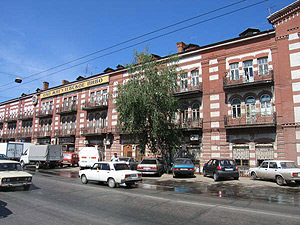 |
|
The brewery was founded by Austrian Alfred von Wakano in 1881, one year after his arrival in the city. The industrial brewery building is a sight in itself, but these days there is also a small bar and restaurant in the building that serves some moderately-priced Russian food and, of course, the brewery's produce. Honestly, Zhigulevskoe beer isn't great - it was originally conceived as a budget beer and remains so today, meaning that the quality suffers. Von Wakano seemed to like it enough though. Apparently he had beer pipeline from the brewery to his house installed so that he would be in constant supply. At least until the Revolution when von Wakano was forced to flee and his Samara-born sons were apparently killed. Von Wakano's house (Rabochaya Ul., #3) is also worth a look for its architectural merits.
Address: Volzhsky Prospekt, #4. Tel: 264-2116.
Ploshchad Chapaeva.
In the center of this small square stands a monument to Chapaev, designed by
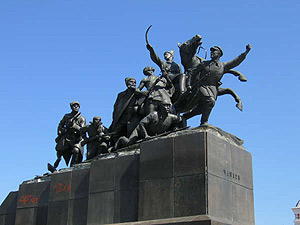 |
|
Matvei Manizer in 1932. Vasily Chapaev himself was a distinguished military commander who joined the Bolshevik Party in 1917 and subsequently fought against the White Army in the Civil War. He disappeared after an ambush in 1919 when he tried to escape by swimming across a river. He posthumously rose to legendary status after the publication of a book called Chapaev by Dmitry Furmanov in 1924. The book was made into a popular movie ten years later. The striking statue features Chapaev at the front of a band of soldiers, urging them onwards.
Directions: Ploshchad Chapaeva is on the corner of Frunze Ulitsa and Rabochaya Ulitsa.
Samara Drama Theatre.
The main feature on the
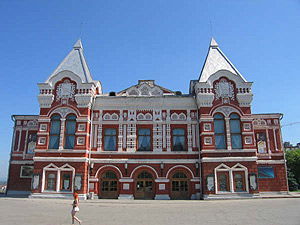 |
|
Ploshchad Chapaeva is the Samara Drama Theater. Construction of this beautiful building finished in 1888, under the guidance of architect Mikhail Chichagov who designed it in a "Moscow baroque" style. Locals are very proud of their theater, both the building and the quality of productions performed there, so catching a performance while in town could be a good option. The ticket office is on the north side (closest to the Volga) of the theater and is open from 11:00-18:30 daily except Mondays.
Address: Ploshchad Chapaeva, #1. Tel: 233-3348.
Ploshchad Revolutsii.
At the very center of the city stands this small square, which
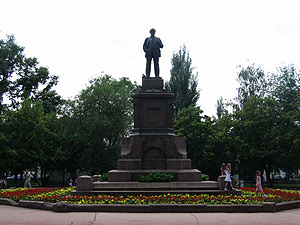 |
|
inconveniently stands in the middle of an intersection between two busy roads. Taking pride of place in the middle of the square is the ubiquitous Lenin statue, this particular one sculpted by Matvei Manizer. A statue of Alexander II used to stand in this spot until it was toppled in favor of the symbol of the new regime. Incidentally, the young Lenin once worked in the building across from the square which houses the district court, (Kuibysheva Ul., #66). Although it's not a particularly spacious or beautiful square, Ploshchad Revolutsii is popular with families and acts as a meeting point in the city. There are just enough grassy areas to keep the children satisfied.
Directions: The square is in the very center of the city where Kuibysheva Ulitsa intersects with Ventseka Ulitsa.
Pokrovsky Cathedral.
The Pokrovsky Cathedral is a beautiful church both
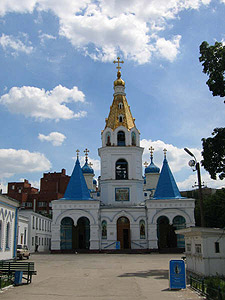 |
|
outside and inside. Built in 1861 it ranks as one of Samara's oldest standing churches. Apparently at the start of the 20th Century it was even more lavishly decorated, but many of its riches were sold off to feed local citizens in the 1920s. Pokrovsky Cathedral was also the last church in Samara to be closed after the revolution, keeping its doors open until 1946. The grounds around the church aren't large but the overall ensemble and elegant entrance gates make a delightful overall impression. Entrance to the church is free. You can also try some of the bread that is baked on the grounds.
Address: Leninskaya Ul., #75a.
Museums in Samara.
Stalin's Bunker.
When the German's had almost reached Moscow in 1941 Samara was chosen as a 'reserve' capital, mainly for its advantageous geographical location. While many of the top Kremlin officials were relocating to Samara work had begun on accommodation for Stalin. A team of more than 500 metro builders from Moscow, sworn to complete secrecy, were brought to Samara to construct the bunker. The 8-meter diameter shaft down to the bunker was dug by hand to an incredible depth of 37 meters. The project was carried out in complete secrecy so that not even the neighbors knew that construction was going on. These days the bunker is a museum, and would probably be Samara's greatest tourist attraction if it wasn't so hard to get into. You have to go with a tour group to see it. Individual tourists might be able to tag along with a tour group but the chances aren't good. If you make it down the shaft you'll see the bunker preserved as it was in the 1940s. Features include a conference hall, offices for the top Kremlin brass, living rooms, a dining room, all adorned in an amazingly opulent fashion. Incidentally, Stalin decided to stay in Moscow so never used the bunker himself.
Address: Frunze Ul., #167. Tel: 233-4433. Tour groups only.
The Alabin Samara Regional History Museum.
Samara's biggest and most comprehensive museum has displays on everything to do with Samara and the surrounding region. There are exhibits on archaeology and paleontology in the region, including dinosaur bones that were discovered locally. The ethnographical section has exhibits about the people who lived in the Volga area long before
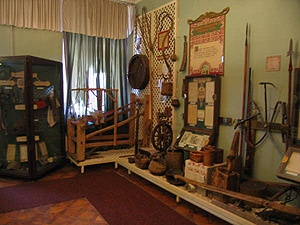 |
|
Samara existed. The modern history section is heavy on Samara during World War Two and there are also religious, art and nature collections among many other subjects. The museum has three affiliates in other parts of Samara. The Kurlin Mansion (Frunze Ul., #159. Tel: 233-2498. Open Tues-Sun 10-18) mainly covers the history of the city of Samara from 1586 until the start of the 20th Century. They make you wear ridiculous, big slippers over your shoes so you don't harm the floorboards. The House-Museum of Mikhail Frunze (Frunze Ul., #114. Tel: 233-6636. Open Mon-Sat 10-18) is devoted to the Russian Civil War in general. But maybe the biggest attraction is the House-Museum of the Ulyanov Family (Leninskaya Ul., #131. Tel: 232-3668. Open Mon-Sat 9-17), which is the house where the young Lenin lived with his family from 1890-93. Admission to each museum costs 15R ($0.55) for students, 30R ($1.10) for adults and 60R ($2.20) for foreigners.
Address: Leninskaya Ul., #142. Tel: 332-2102. Website: www.alabin.ru. Open Tue-Sun 10:00-18:00.
The War History Museum.
A much larger and better museum than you would probably expect, the Samara War History Museum is a nice surprise.
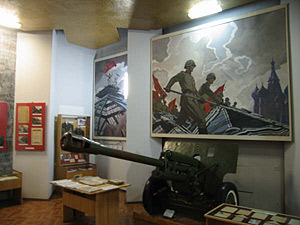 |
|
Although in a city that seems quite proud of its role in the World War 2, perhaps it's understandable that this museum is good quality. The museum almost exclusively focuses on this war, when Samara was made the 'reserve' capital of Russia and assisted the Russian war effort through its aviation industry. The museum has a lot of displays of weaponry and many other artifacts. But possibly the most alluring objects in the museum are the attention-grabbing war-time paintings. There is also a large, interesting diorama of a battle, complete with sounds effects. Admission costs 15R ($0.55) for students, 20R ($0.75) for adults and 50R ($1.85) for foreigners.
Address: Rabochaya Ul., #1. Tel: 232-0970. Open 10:00-17:00, closed Saturday and Monday.



